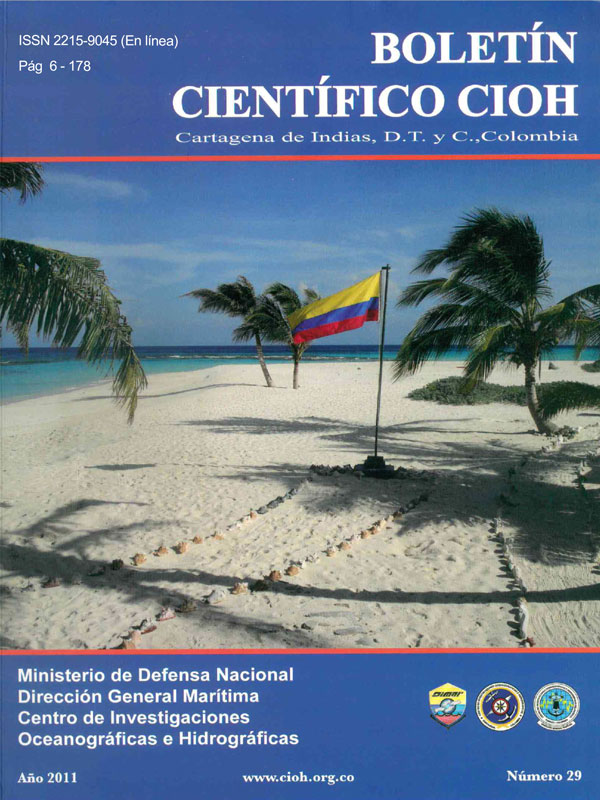Evaluación temporal de parámetros fisicoquímicos en una estación oceánica frente a la Bahía de Tumaco
DOI:
https://doi.org/10.26640/22159045.236Keywords:
Ocean station, Tumaco Bay, phisicochemical parametersAbstract
The paper evaluated the temporal behavior of some physicochemical parameters (salinity, temperature, dissolved oxygen and chlorophyll) and nutrients associated oceanographic conditions in the Pacific, the evaluation was performed based at the results of a biweekly monitoring performed during 2008 to 2009 an oceanic station located off the Bay of Tumaco. The observed variability in these parameters is attributed to factors related to the influence of the migration of the Intertropical Convergence Zone (ITCZ), the wind direction and current Colombia. In this respect a marked change in the normal behavior of the isotherm and isohaline of the column appeared in the first quarter of each year, presenting a delta of 7oC for temperature and 4 ups for salinity, attributable in part to the emergence of cold water currents caused by subsurface depth currents (currents generated below 100 meters) and favored by the direction of the winds at the time going in a northeasterly direction due to movement of the ITCZ, this emergence associate a increased concentrations of inorganic nutrients, which reached levels of up to 5 μg-at N-NO3-/L for nitrate, 0.4 μg-at P-(PO4)-3/L to phosphate, and 1 μg-at N-NH4+/L for ammonium, higher than those normally presented at the point of study, the changes in the physicochemical conditions of the area were more intensely during the second year of monitoring (2009), also manifest with an increase in the concentration of chlorophyll a and dissolved oxygen, with values up to 2.1 mg/m3 and 7.25 mg O2/L respectively.Downloads
References
[2] Devis Morales Andrea. Análisis de las condiciones oceanográficas y meteorológicas de la bahía de Tumaco y su relación con eventos de escala global. Boletín Científico CCCP 2003; Número 9: 1-21.
[3] Devis Morales Andrea. Evolución del evento el niño 2002-2003 y efectos sobre la cuenca del Pacífico colombiano y la bahía de Tumaco. Boletín Científico CCCP 2003; Número 10: 12-32.
[4] García H. Ingrid, Málikov Igor. Comportamiento de diatomeas y dinoflagelados en la bahía de Tumaco bajo la influencia de cambios climáticos durante el período 1995-2000. Boletín Científico CCCP 2003; Número 9: 22-23.
[5] Strickland, J.D, Parsons T.R. A practical handbook of seawater analysis. Second Edition. Ottawa (Canada): Fisheries Re-search Board of Canada; 1972.
[6] Bendschneider, K., Robinson, R.J. A new Spectrophotometric Method for the determination of nitrite in sea water. Volumen 11. Journal Marine Research; 19520.
[7] Murphy, J. y Riley J. P. A modified single solution method for the examination of phosphate in natural water. Acta 27. Liverpool (England): Anal. Chim; 1962.
[8] Standard methods for the examination of water and wastewater. 21th Edition. APHA, AWWA, WPCF; 2005.
[9] Stevenson Merritt, Guillen G. Oscar, Santoro de Ycaza José. Marine atlas of the pacific coastal waters of South America. Berkeley (EEUU): University of California Press; 1970.
[10] Tejada Vélez Carlos, Guayana Labrador Erick et al. Compilación oceanográfica de la cuenca Pacífica colombiana. Tumaco (Colombia): Centro Control Contaminación del Pacífico – CCCP, Dirección General Marítima; 2002.
[11] Olsen, Y., Helge, R., Olav V., Tom, A., Ingrid, G., Carlos, D., Susana, A., Herwig, S., Ulrich, S., Risto, L. Timo, T. et al. Comparative analysis of food webs based on flow networks: effects of nutrient supply on structure and function of coastal plankton communities. Vol 21. Continental Shelf Research; 2001.
Downloads
Published
Issue
Section
License
Attribution — You must give appropriate credit, provide a link to the license, and indicate if changes were made. You may do so in any reasonable manner, but not in any way that suggests the licensor endorses you or your use.
NonCommercial — You may not use the material for commercial purposes.
NoDerivatives — If you remix, transform, or build upon the material, you may not distribute the modified material.
No additional restrictions — You may not apply legal terms or technological measures that legally restrict others from doing anything the license permits.










